How can visual assistance contribute to reducing the Customer Effort Score



Customer loyalty is a major issue for companies. But what really keeps a customer? According to Gartner, it is the level of effort that the consumers have to deploy to interact with a brand that would impact their loyalty level. In this article, we will explain the Customer Effort Score, its importance for customer retention and how to optimize it thanks to visual assistance.
The Customer Effort Score (CES) is an indicator that measures how easy it is for a customer to contact and interact with a company.
The CES was popularized in 2010 thanks to a Harvard Business Review article entitled “Stop Trying to Delight Your Customers“. This article highlights research conducted by the Corporate Executive Board (now Gartner) that shows that customer loyalty is not achieved by offering exceptional services, but by reducing their effort, meaning the “work” they have to put in to get an answer or resolution to their problem. Effort is therefore a factor in customer loyalty, as 96% of customers with high-effort experiences reported being unfaithful, compared to only 9% of customers with low-effort experiences. The study also shows that improving effort levels can help improve customer service, reduce service costs and increase customer retention.
Effort is considered high when the customer has to go through many steps to reach their goal. The main sources of effort then are:
To know its Customer Effort Score, the company must question its customers via a survey. There are three types of scales to measure it: the numbered scale, the Likert scale or the emoticon scale.
Numbered scales
Sample question, “How easy was it for you to solve your problem?”
This type of question typically imposes 5 levels of response ranging from “Very Difficult” to “Very Easy”. The order of the answers can also be reversed from “Very easy” to “Very difficult”.
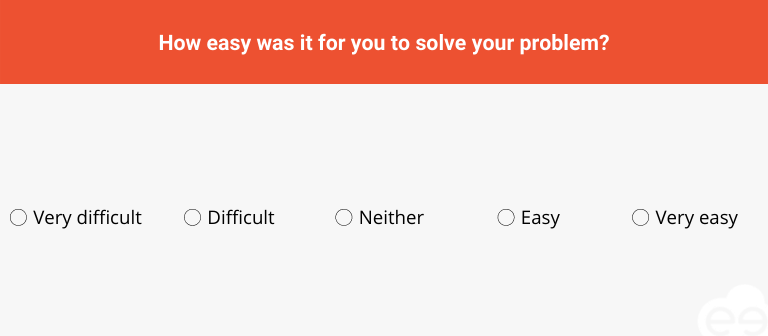
Sample question, “How much effort did it take to solve your problem?”
For this type of question, it is strongly advised to guide the respondents by indicating the desired system either by mentioning “1 = little effort and 10 = a lot of effort”, or by using a color code from green to red for more clarity.
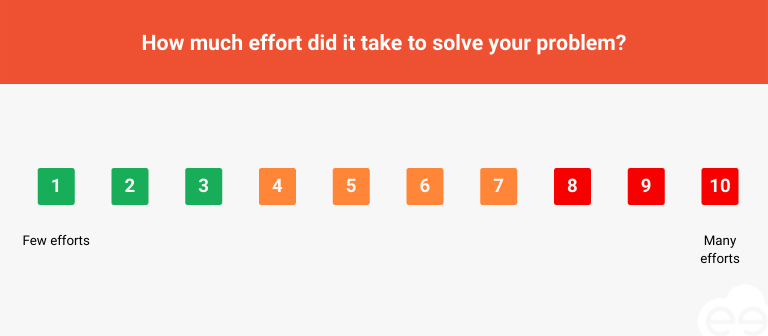
Likert scale
Sample question, “Do you agree with the following statement: Customer service made it easy for me to resolve my problem ? ”
The Likert scale is regularly used in research questionnaires. This method involves writing down a statement and asking customers to indicate the extent to which they agree or disagree with it. It involves a 7-point scale.
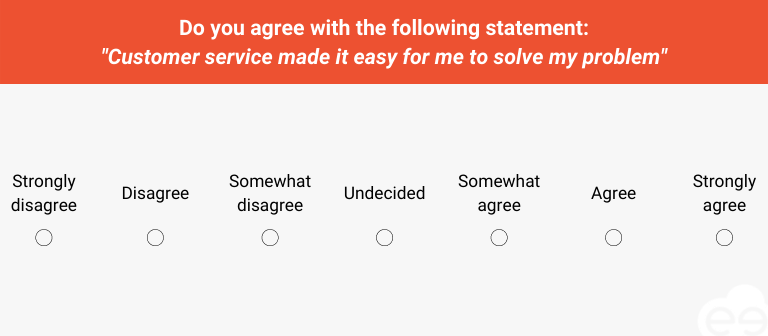
Emoticon Scale
Sample question, “How easy was it for you to get in touch with our customer service?”
Typically, companies use a scale of 3 responses: a happy emoticon, a neutral emoticon, and an unhappy emoticon. The use of emojis encourages customers to respond quickly and easily.
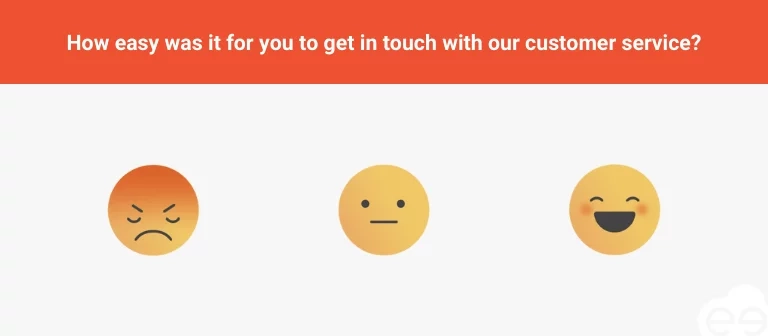
The Customer Effort Score is used to find out how customers perceive specific aspects of the company. There are 3 important moments to question customers:
It is preferable to measure the CES directly after these actions, because the customer’s experience is recent and their feelings are still fresh in their memory. This way, the comments collected will be more complete and reliable.
Once the data is collected, it remains to calculate it. There are 3 possible calculation methods: the average of responses, the NPS calculation and the Net Easy Score.
The average of responses
This is the simplest method. It is sufficient to average the responses obtained. Depending on the scale established for the question, you will obtain a score out of 5, 7 or 10.
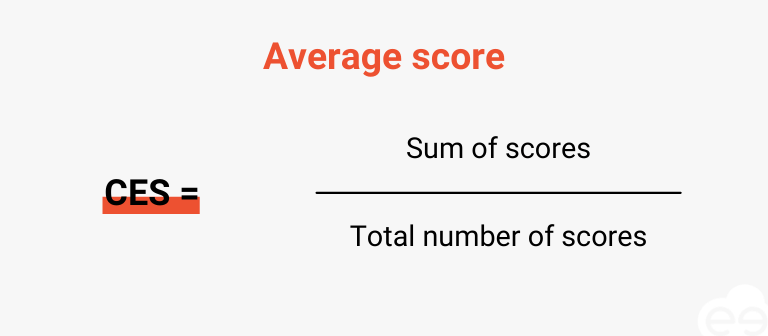
The NPS calculation
This calculation method is similar to the NPS (Net Promoter Score). Unlike the NPS, the objective here is to obtain the lowest possible score. This calculation can be used for different scales, from 1 to 5, 1 to 10 or Likert (1 to 7).
Like the NPS, this formula consists in segmenting the customers’ answers into 3 categories. Let’s take the example of a Likert scale:
The calculation consists of subtracting the low effort percentage from the high effort percentage. The score obtained is between -100 (minimum effort level) and +100 (maximum effort level). A low CES will mean that customers did not have to make much effort to perform a certain action and that they are satisfied with the experience.
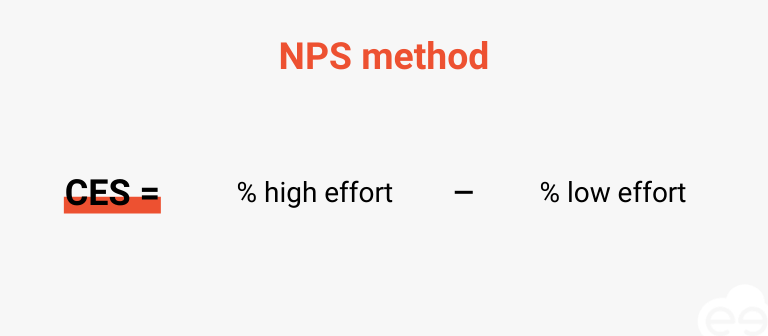
The Net Easy Score
The Net Easy Score measures how easy it was for the customer to interact with the company. Similarly, the responses are divided into 3 categories:
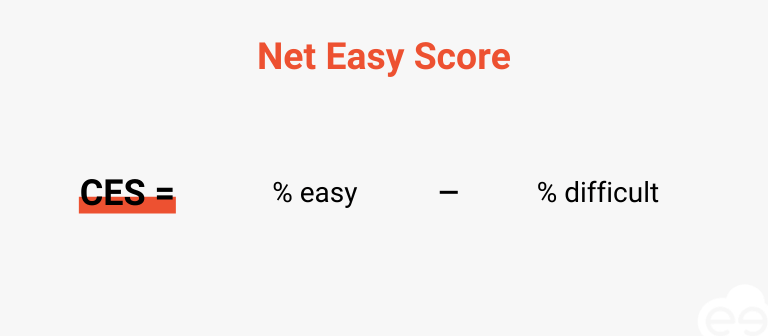
Discover our free Customer Effort Score calculator and evaluate your customer experience.
CalculateAs you can see, there is no reference score for a good CES. Indeed, the questions, the measurement scales and the calculation methods may differ from one company to another. This makes it difficult to benchmark the customer effort score. Regardless, the goal is to provide an easy and effortless experience for customers.
If your CES is good, then you can consider the process or touch point to be enjoyable for your customers. You should continue to collect feedback from your customers and monitor the score.
If your CES is not good, then you need to act! The Customer Effort Score tells you that customers have to put in a lot of effort to get something done, but it doesn’t tell you why. It could be your website, one of your employees or something else. So you need to conduct research such as asking follow-up questions, conducting user tests or in-depth interviews with customers. Once you’ve identified the issues, you’ll need to put an action plan in place to correct them and then continue to test your customer effort score to make sure that there is an improvement over time.
Generally speaking, customers want to spend as little effort as possible to perform an action, use a product/service or solve a problem. If the company asks for too much effort, it is very likely that customers will turn to the competition. Measuring customer effort is therefore important to determine customer satisfaction and future behavior. Popular with companies, the Customer Effort Score has many advantages:
The CES is a vector for continuous improvement
Easy to implement, the Customer Effort Score gives a clear and precise vision of the areas that need to be improved. For example, if customers report a high level of effort to reach customer service, then the company knows it needs to make changes in this area.
CES predicts customers’ future buying behavior
A company that offers a simple buying process, in other words, has a good customer effort score, is more likely to have a customer return multiple times. In fact, the Harvard Business Review article found that 94% of customers who have had low-effort experiences intend to buy from these brands again.
CES affects customer recommendations
The cost of a bad customer experience can be high. That’s because in addition to losing a customer, the company risks damage to its reputation if the customer communicates about the negative experience. According to the same article, 81% of customers who consider themselves to have gone to great lengths said they would speak negatively about the company to others. This also works the other way around, as a consumer who is satisfied with the low effort will also recommend the brand and possibly become an ambassador.
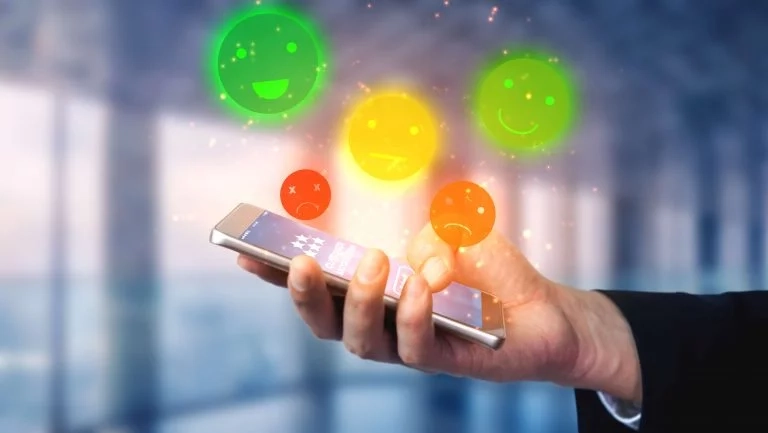
CES plays a major role in customer loyalty
Customer loyalty is the result of repeated positive experiences with a company. Customer satisfaction can be related to products/services, brand awareness, associated services, etc. But it can also come from the ease of the experience. In fact, according to Gartner, making customers’ lives easier is a faster and more effective way to retain them. So by reducing customer effort through CES calculations, a company can maximize customer retention and increase their lifetime value.
CES helps reduce customer service costs
A low-effort interaction costs 37% less than a high-effort interaction. Low-effort experiences reduce costs by decreasing repeat calls by up to 40%, escalations by 50% and channel switching by 54%. By measuring the Customer Effort Score, companies can identify recurring pain points that could be optimized. Once identified and resolved through CES, these repeated and costly interactions for the business will decrease and make customer journeys smoother.
CES drives employee retention
When customer service teams provide a better experience for customers, they feel more engaged in their work and their intent to stay with the company increases by up to 17% according to Gartner.
Visual assistance for customer relations is a tool that allows you to transform your customer paths and optimize all your services: sales, remote quotation, customer service, pre-diagnosis or quality monitoring. Video communication allows you to handle your customers’ requests efficiently and quickly while offering a human-centered digital experience.
We all know that the main source of customer frustration is having to contact a company’s customer service department following a problem encountered, and then waiting for a response. Indeed, this is an often stressful and frustrating step for customers. The Gartner study also reveals that customer service interactions lead to more disloyalty than loyalty.
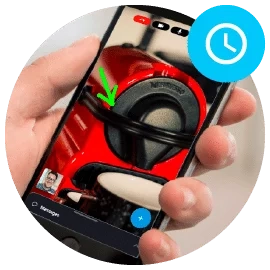
In the case of customer support, video support allows customer advisors to assist customers in real time and remotely. When a customer contacts a brand’s customer service department to solve a problem or get an answer to a functional question, the agent can offer to perform video support. To do so, he creates and sends the customer an invitation by sms or email in less than a minute. Thanks to the 100% web interface, the customer does not need to download an application or create an account. The visual assistance can be done from a computer, a tablet or a smartphone. With a single click on the link received, the customer launches the video session and can show his environment to the agent via his camera. The advisor then uses his knowledge to advise and guide the customer in solving his problem. He can also establish a diagnosis, anticipate and better prepare an intervention if it is necessary.
Deploying a video solution in customer relations departments brings interesting benefits for customers:
In general, visual assistance is an interesting tool to reduce the efforts to be made, the negative feelings perceived by the customers and finally to reduce the Customer Effort Score at the customer service level. To measure the Customer Effort Score related to visual assistance interventions, you have the possibility to submit a survey to the customer at the end of the video call session. The survey is customizable and you can add up to 8 questions. By following up directly after each interaction, you will be able to collect and analyze the data and measure your CES. Based on the score you get, you will have an idea of your customers’ experience and can optimize your customer service.
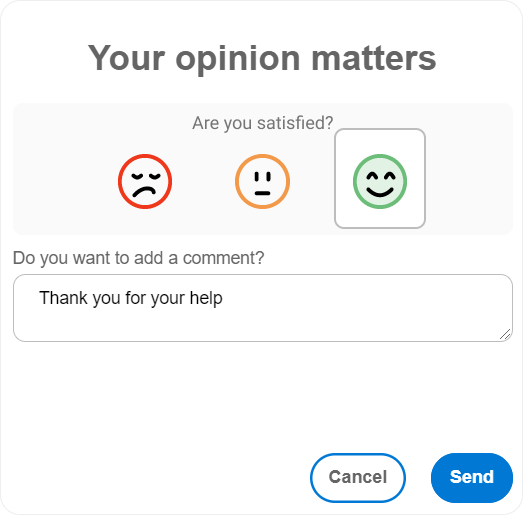
The Customer Effort Score is a KPI not to be neglected. By keeping track of your score, you can improve your customers’ experience, turn potential detractors into ambassadors and optimize your loyalty strategy. Do you want to integrate video support into your strategy to improve your customer effort score? We can help you! We are listening to your needs and would be delighted to discuss your project.
I want to know more I want to see a demo
Read also:
Claire Boscq, CX Activator and founder of JCX Alliance, shares her unique approach to wellbeing-led customer experience. Discover her vision in this new Apizee CX Voices interview.
[CX Industry Voices] Interview with Claire Boscq
25 Jun 2025
Call Centre Helper’s Xander Freeman spoke to Charles Kergaravat, CMO at Apizee, about the rise of video chat in customer service.
The rise of Video Chat in customer service
20 Jun 2025
Simon Macklin from Salesforce, explains how AI and human empathy combine to shape the future of CX. Discover insights in the latest Apizee CX Voices interview.
[CX Industry Voices] Interview with Simon Macklin
19 Jun 2025
Interested in our solutions?